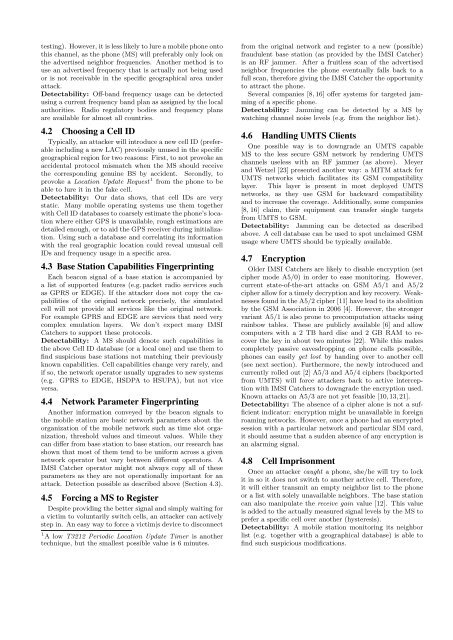AdrianDabrowski-IMSI-Catcher-Catcher-ACSAC2014-preprint-20140820
AdrianDabrowski-IMSI-Catcher-Catcher-ACSAC2014-preprint-20140820
AdrianDabrowski-IMSI-Catcher-Catcher-ACSAC2014-preprint-20140820
Create successful ePaper yourself
Turn your PDF publications into a flip-book with our unique Google optimized e-Paper software.
testing). However, it is less likely to lure a mobile phone onto<br />
this channel, as the phone (MS) will preferably only look on<br />
the advertised neighbor frequencies. Another method is to<br />
use an advertised frequency that is actually not being used<br />
or is not receivable in the specific geographical area under<br />
attack.<br />
Detectability: Off-band frequency usage can be detected<br />
using a current frequency band plan as assigned by the local<br />
authorities. Radio regulatory bodies and frequency plans<br />
are available for almost all countries.<br />
4.2 Choosing a Cell ID<br />
Typically, an attacker will introduce a new cell ID (preferable<br />
including a new LAC) previously unused in the specific<br />
geographical region for two reasons: First, to not provoke an<br />
accidental protocol mismatch when the MS should receive<br />
the corresponding genuine BS by accident. Secondly, to<br />
provoke a Location Update Request 1 from the phone to be<br />
able to lure it in the fake cell.<br />
Detectability: Our data shows, that cell IDs are very<br />
static. Many mobile operating systems use them together<br />
with Cell ID databases to coarsely estimate the phone’s location<br />
where either GPS is unavailable, rough estimations are<br />
detailed enough, or to aid the GPS receiver during initialization.<br />
Using such a database and correlating its information<br />
with the real geographic location could reveal unusual cell<br />
IDs and frequency usage in a specific area.<br />
4.3 Base Station Capabilities Fingerprinting<br />
Each beacon signal of a base station is accompanied by<br />
a list of supported features (e.g. packet radio services such<br />
as GPRS or EDGE). If the attacker does not copy the capabilities<br />
of the original network precisely, the simulated<br />
cell will not provide all services like the original network.<br />
For example GPRS and EDGE are services that need very<br />
complex emulation layers. We don’t expect many <strong>IMSI</strong><br />
<strong>Catcher</strong>s to support these protocols.<br />
Detectability: A MS should denote such capabilities in<br />
the above Cell ID database (or a local one) and use them to<br />
find suspicious base stations not matching their previously<br />
known capabilities. Cell capabilities change very rarely, and<br />
if so, the network operator usually upgrades to new systems<br />
(e.g. GPRS to EDGE, HSDPA to HSUPA), but not vice<br />
versa.<br />
4.4 Network Parameter Fingerprinting<br />
Another information conveyed by the beacon signals to<br />
the mobile station are basic network parameters about the<br />
organization of the mobile network such as time slot organization,<br />
threshold values and timeout values. While they<br />
can differ from base station to base station, our research has<br />
shown that most of them tend to be uniform across a given<br />
network operator but vary between different operators. A<br />
<strong>IMSI</strong> <strong>Catcher</strong> operator might not always copy all of these<br />
parameters as they are not operationally important for an<br />
attack. Detection possible as described above (Section 4.3).<br />
4.5 Forcing a MS to Register<br />
Despite providing the better signal and simply waiting for<br />
a victim to voluntarily switch cells, an attacker can actively<br />
step in. An easy way to force a victim|s device to disconnect<br />
1 A low T3212 Periodic Location Update Timer is another<br />
technique, but the smallest possible value is 6 minutes.<br />
from the original network and register to a new (possible)<br />
fraudulent base station (as provided by the <strong>IMSI</strong> <strong>Catcher</strong>)<br />
is an RF jammer. After a fruitless scan of the advertised<br />
neighbor frequencies the phone eventually falls back to a<br />
full scan, therefore giving the <strong>IMSI</strong> <strong>Catcher</strong> the opportunity<br />
to attract the phone.<br />
Several companies [8, 16] offer systems for targeted jamming<br />
of a specific phone.<br />
Detectability: Jamming can be detected by a MS by<br />
watching channel noise levels (e.g. from the neighbor list).<br />
4.6 Handling UMTS Clients<br />
One possible way is to downgrade an UMTS capable<br />
MS to the less secure GSM network by rendering UMTS<br />
channels useless with an RF jammer (as above). Meyer<br />
and Wetzel [23] presented another way: a MITM attack for<br />
UMTS networks which facilitates its GSM compatibility<br />
layer. This layer is present in most deployed UMTS<br />
networks, as they use GSM for backward compatibility<br />
and to increase the coverage. Additionally, some companies<br />
[8, 16] claim, their equipment can transfer single targets<br />
from UMTS to GSM.<br />
Detectability: Jamming can be detected as described<br />
above. A cell database can be used to spot unclaimed GSM<br />
usage where UMTS should be typically available.<br />
4.7 Encryption<br />
Older <strong>IMSI</strong> <strong>Catcher</strong>s are likely to disable encryption (set<br />
cipher mode A5/0) in order to ease monitoring. However,<br />
current state-of-the-art attacks on GSM A5/1 and A5/2<br />
cipher allow for a timely decryption and key recovery. Weaknesses<br />
found in the A5/2 cipher [11] have lead to its abolition<br />
by the GSM Association in 2006 [4]. However, the stronger<br />
variant A5/1 is also prone to precomputation attacks using<br />
rainbow tables. These are publicly available [6] and allow<br />
computers with a 2 TB hard disc and 2 GB RAM to recover<br />
the key in about two minutes [22]. While this makes<br />
completely passive eavesdropping on phone calls possible,<br />
phones can easily get lost by handing over to another cell<br />
(see next section). Furthermore, the newly introduced and<br />
currently rolled out [2] A5/3 and A5/4 ciphers (backported<br />
from UMTS) will force attackers back to active interception<br />
with <strong>IMSI</strong> <strong>Catcher</strong>s to downgrade the encryption used.<br />
Known attacks on A5/3 are not yet feasible [10, 13, 21].<br />
Detectability: The absence of a cipher alone is not a sufficient<br />
indicator: encryption might be unavailable in foreign<br />
roaming networks. However, once a phone had an encrypted<br />
session with a particular network and particular SIM card,<br />
it should assume that a sudden absence of any encryption is<br />
an alarming signal.<br />
4.8 Cell Imprisonment<br />
Once an attacker caught a phone, she/he will try to lock<br />
it in so it does not switch to another active cell. Therefore,<br />
it will either transmit an empty neighbor list to the phone<br />
or a list with solely unavailable neighbors. The base station<br />
can also manipulate the receive gain value [12]. This value<br />
is added to the actually measured signal levels by the MS to<br />
prefer a specific cell over another (hysteresis).<br />
Detectability: A mobile station monitoring its neighbor<br />
list (e.g. together with a geographical database) is able to<br />
find such suspicious modifications.



